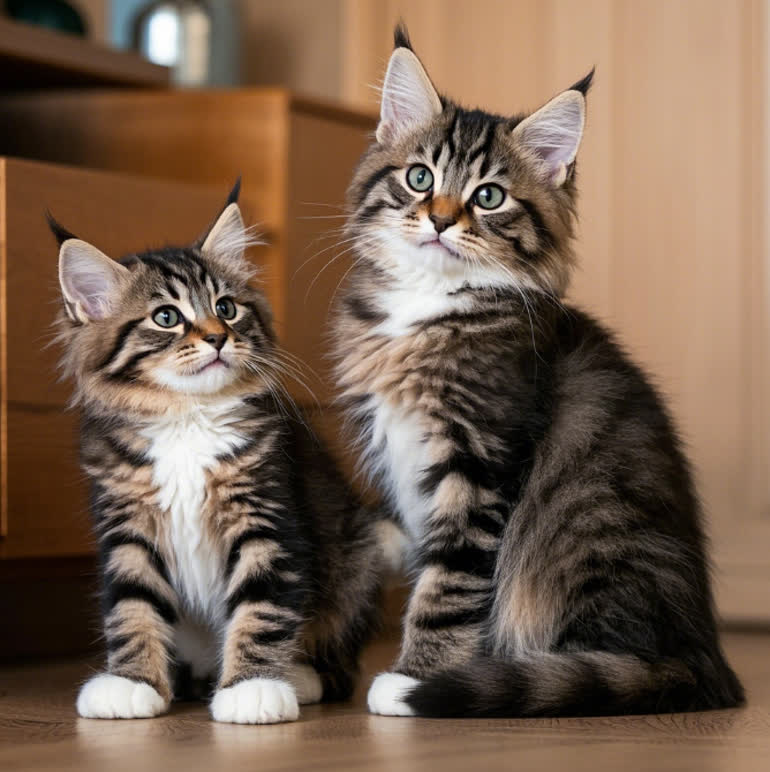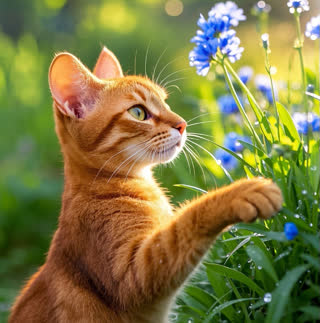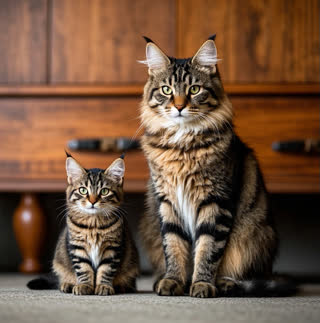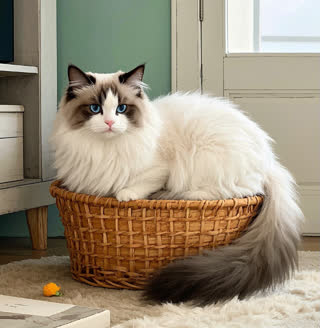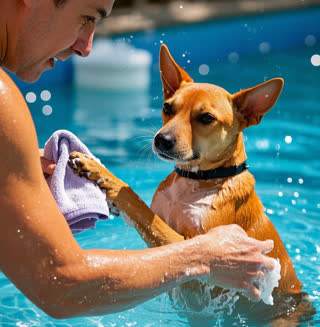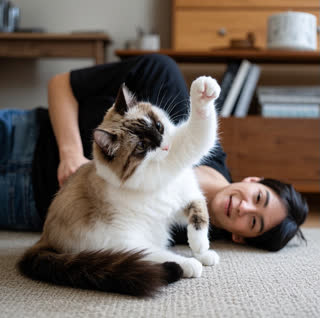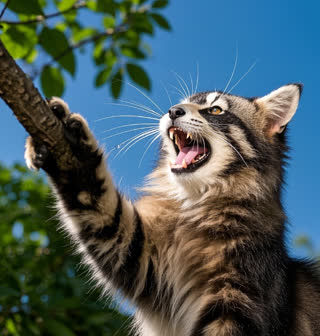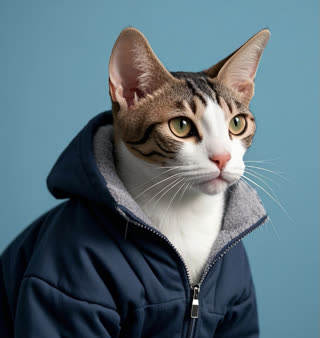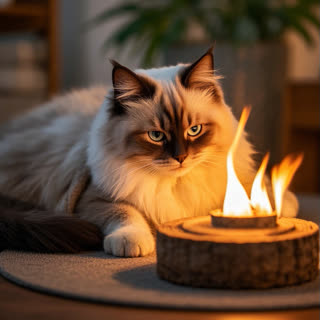Introduction
1 Introduction to Hypoallergenic Cats
2 Key Characteristics of Hypoallergenic Cats
3 Top 10 Hypoallergenic Cat Breeds
4 How to Care for Hypoallergenic Cats
5 Common Misconceptions About Hypoallergenic Cats
6 Choosing the Right Hypoallergenic Cat for Your Lifestyle
7 onclusion: Living Allergy-Free with Your Feline Companion
![]() Introduction to Hypoallergenic Cats
Introduction to Hypoallergenic Cats
Understanding Cat Allergies
Cat allergies are a common issue that affects many people. The primary allergen responsible for triggering allergic reactions in humans is a protein called Fel d1. This protein is produced in the sebaceous glands of cats and is present in their saliva, skin, and urine. When a cat grooms itself, Fel d1 is spread throughout its fur, and tiny particles of the protein, known as dander, can become airborne. When an allergic person inhales these dander particles, their immune system mistakes the Fel d1 protein for a harmful invader and launches an immune response. This response leads to the release of histamine and other chemicals, causing a variety of allergy symptoms such as sneezing, itchy eyes, a runny nose, and skin rashes.
It's important to note that no cat breed is completely 100% allergen - free. All cats produce the Fel d1 protein to some extent, but the levels can vary significantly among different breeds. Even within the same breed, individual cats may produce different amounts of the allergen. Additionally, factors like a cat's age, health, and grooming habits can also influence the amount of Fel d1 in the environment.
Why Hypoallergenic Breeds Matter
For those who suffer from cat allergies but still long for the companionship of a feline friend, hypoallergenic cat breeds offer a glimmer of hope. These breeds are often touted as being more tolerable for allergy sufferers due to their reduced production of the Fel d1 protein. Lower levels of this allergen mean that there are fewer particles in the air and on surfaces, reducing the likelihood of an allergic reaction.
Another important factor is the shedding frequency of these breeds. Cats that shed less are less likely to spread dander around the house. Since dander is a major carrier of the Fel d1 protein, minimizing shedding can significantly decrease the allergen load in the living environment. Hypoallergenic breeds typically have coats that are either short, fine - textured, or have a unique hair structure that reduces the amount of loose hair and dander they release. This makes them a more suitable choice for people with allergies, allowing them to enjoy the company of a cat with fewer allergy - related discomforts.
![]() Key Characteristics of Hypoallergenic Cats
Key Characteristics of Hypoallergenic Cats
Coat Type
The coat type of a cat is a crucial factor in determining its hypoallergenic properties. Short - haired breeds, such as the Siamese, tend to produce less dander compared to long - haired breeds. Dander, which consists of tiny flakes of dead skin, is a major carrier of the Fel d1 allergen. Since short - haired cats have less hair to trap and spread dander, they are often more tolerable for allergy sufferers.
Hairless breeds, like the Sphynx, are another popular choice for those with allergies. At first glance, it might seem counterintuitive that a cat with no hair could be hypoallergenic, but in fact, without a full coat of fur, there is less surface area for dander to accumulate and be released into the air. However, it's important to note that Sphynx cats still produce the Fel d1 protein in their sebaceous glands, and they require regular bathing to remove the natural oils and potential allergens from their skin.
Grooming Habits
Grooming habits play a significant role in the allergen levels associated with a cat. Cats that are self - grooming enthusiasts can actually help minimize the spread of allergens. When a cat grooms itself, it uses its rough tongue to remove loose hair, dirt, and dander from its coat. This natural cleaning process helps to keep the amount of allergen - carrying particles on the cat's body to a minimum.
For example, the Devon Rex is known for its fastidious self - grooming habits. This breed has a soft, curly coat that doesn't shed much, and its frequent grooming helps to further reduce the amount of dander that could potentially become airborne. Additionally, regular grooming by the owner, such as brushing the cat's coat, can also help to remove loose hair and dander before they have a chance to spread around the house. However, it's important for allergy sufferers to wear a mask and wash their hands thoroughly after grooming a cat to avoid direct contact with the allergens.
Temperament
The temperament of a cat can also impact how much of an allergic reaction a person may have. Calm and non - shedding cats are generally better for allergy sufferers because they reduce the amount of human - cat contact that could potentially expose the person to allergens. A cat that is constantly on the move, jumping on furniture, and rubbing against people is more likely to spread dander around the living environment.
Breeds like the Russian Blue are known for their calm and gentle temperaments. They are not overly active or demanding, which means they are less likely to cause a commotion that could stir up allergens. This breed also has a short, dense coat that sheds minimally, further reducing the allergen load in the home. In contrast, a highly energetic and active cat breed may shed more hair during its active playtime and increase the chances of an allergic reaction in sensitive individuals.
![]() Top 10 Hypoallergenic Cat Breeds
Top 10 Hypoallergenic Cat Breeds
1. Russian Blue
Profile: The Russian Blue is a breed that exudes elegance with its sleek, silver - blue coat. Its short, dense fur has a unique sheen that gives it a distinct appearance. These cats are known for their intelligence; they can quickly learn simple tricks and are quite observant of their surroundings. Their quiet demeanor makes them a great choice for those who prefer a more peaceful feline companion. They are not overly vocal but will communicate with soft meows when they need attention or have something to “say.”
Allergy - Friendly Traits: One of the main reasons the Russian Blue is considered hypoallergenic is its low - shedding coat. Since it sheds less, there are fewer loose hairs that can carry dander, the primary carrier of the Fel d1 allergen. Additionally, studies have shown that Russian Blues produce relatively minimal amounts of the Fel d1 protein. This combination of low shedding and reduced allergen production makes them a popular choice among allergy sufferers. For example, many people who are allergic to cats but have brought a Russian Blue into their homes report significantly fewer allergy symptoms compared to when they were around other cat breeds.
2. Sphynx
Profile: The Sphynx is an unmistakable breed due to its hairless appearance. Its wrinkled skin gives it a unique, almost alien - like look. Despite its lack of fur, the Sphynx has a warm and outgoing personality. These cats are extremely social and love to be the center of attention. They are often described as dog - like in their loyalty and will follow their owners around the house, seeking affection and interaction.
Allergy - Friendly Traits: The most obvious allergy - friendly trait of the Sphynx is its lack of fur. Without a coat, there is no fur to trap and spread dander, which is a major source of the Fel d1 allergen. However, it's important to note that Sphynx cats still produce the allergen in their sebaceous glands. To keep allergen levels down, they require regular bathing, usually once or twice a week. This helps to remove the natural oils and any potential allergens from their skin. By maintaining a regular bathing routine, owners can enjoy a relatively allergen - free environment with their Sphynx companions.
3. Devon Rex
Profile: The Devon Rex has a curly, short coat that sets it apart from other breeds. Its soft, wavy fur gives it an endearing and somewhat tousled appearance. This breed is known for its playful and affectionate nature. Devon Rex cats are full of energy and love to play with toys, climb, and explore their surroundings. They form strong bonds with their owners and are always eager to be involved in family activities.
Allergy - Friendly Traits: The Devon Rex's coat is sparse and fine, which means it produces reduced amounts of dander. Dander is a major culprit in triggering cat allergies, and the breed's low dander production makes it more tolerable for allergy sufferers. Their fastidious self - grooming habits also contribute to their hypoallergenic qualities. They are constantly cleaning themselves, which helps to keep their fur and skin free of loose dander. This natural grooming behavior, combined with their unique coat structure, makes the Devon Rex a great option for those with allergies who still want an active and loving feline friend.
4. Cornish Rex
Profile: The Cornish Rex has an elegant build with wavy fur that gives it a distinctive look. Its coat is short and lies close to its body, emphasizing its slender physique. These cats are highly social and energetic. They love to interact with their owners, other pets, and even guests. Cornish Rex cats are known for their acrobatic abilities and will often jump and climb to explore high places in the house.
Allergy - Friendly Traits: The Cornish Rex is a low - shedding breed, which significantly reduces the amount of loose hair and dander in the environment. Their gentle grooming needs also make them a good choice for allergy sufferers. Since they don't require excessive grooming, there is less chance of disturbing and spreading allergens. Regular brushing, which is usually sufficient to keep their coat in good condition, can be done with relative ease and minimal exposure to potential allergens. This combination of low shedding and easy grooming makes the Cornish Rex a suitable pet for those with cat allergies.
5. Balinese
Profile: The Balinese has a long, silky coat that flows gracefully as it moves. It is a long - haired breed with a plumed tail and a refined appearance. Balinese cats are vocal and will often “talk” to their owners, expressing their needs and emotions through a variety of meows. They are also extremely loyal and form strong attachments to their human families.
Allergy - Friendly Traits: Despite being a long - haired breed, the Balinese has a fine hair structure that minimizes allergen retention. The individual hairs are fine and less likely to trap and hold onto dander compared to coarser - haired breeds. Their low - shedding nature also helps to keep the amount of allergen - carrying hair in the environment to a minimum. Regular grooming, such as gentle brushing, can further reduce the likelihood of allergens being spread, making the Balinese a more tolerable option for some allergy sufferers.
6. Oriental Shorthair
Profile: The Oriental Shorthair has a slender body and comes in a diverse range of coat colors, making each cat unique. Its almond - shaped eyes and large ears give it an alert and curious expression. These cats are highly curious and love to explore every nook and cranny of their home. They are also quite talkative and will engage in conversations with their owners, often meowing to get attention or express their opinions.
Allergy - Friendly Traits: The Oriental Shorthair has a short, dense fur that reduces dander accumulation. Since dander is a major source of the Fel d1 allergen, the breed's short coat means there is less surface area for dander to attach to and be released into the air. Their active lifestyle also doesn't contribute significantly to increased allergen spread. They are not overly prone to shedding, which helps to keep the allergen levels in the home under control, making them a viable choice for those with mild to moderate cat allergies.
7. British Shorthair
Profile: The British Shorthair has a stocky build with a plush coat that gives it a cuddly appearance. Its round face and large, round eyes make it an endearing breed. These cats are known for their calm and independent nature. They are content to spend time on their own, napping or exploring their territory, but also enjoy affection from their owners when they want it.
Allergy - Friendly Traits: The British Shorthair has moderate shedding, which is more manageable compared to some other breeds. Their adaptability to indoor living means they are less likely to bring in outdoor allergens. Regular grooming can help to keep their coat in good condition and reduce the amount of loose hair and dander. Their calm demeanor also means they don't stir up allergens as much as more active breeds, making them a suitable option for allergy sufferers who want a laid - back feline companion.
8. Bengal
Profile: The Bengal has a wild - looking coat pattern that resembles that of a leopard, with spots or marbled markings. Its muscular build and athletic stance give it a dynamic appearance. Bengals are highly active and love to play, climb, and explore. They have a lot of energy and need plenty of mental and physical stimulation to stay happy.
Allergy - Friendly Traits: The Bengal has a short, dense fur with minimal Fel d1 levels. Its coat is designed to be low - maintenance in terms of shedding. The short hair doesn't trap as much dander, and the reduced Fel d1 production makes it more tolerable for many allergy sufferers. Their active lifestyle doesn't seem to increase allergen spread significantly, and with proper grooming, they can be a great addition to a home with someone who has allergies.
9. Javanese
Profile: The Javanese is a semi - longhair variant of the Siamese. It has a sleek body and a coat that is longer than the Siamese but not as long as some other long - haired breeds. Javanese cats are sociable and intelligent. They are great at interacting with their owners and can learn to respond to commands. They are also quite vocal and will communicate their feelings and needs.
Allergy - Friendly Traits: The Javanese has a low - shedding coat, which helps to keep the amount of allergen - carrying hair in the environment to a minimum. Their gentle grooming habits mean that there is less chance of disturbing and spreading allergens during grooming sessions. Regular brushing, which is relatively easy due to their semi - long hair, can help to remove any loose hair and dander, making them a good choice for those with cat allergies who want a sociable and intelligent feline friend.
10. Savannah
Profile: The Savannah is a tall cat with a spotted coat. It is a hybrid breed, resulting from the cross - breeding of a serval (a wild African cat) and a domestic cat. This gives it a unique and exotic appearance. Savannahs are known for their high energy levels and love to play, jump, and explore. They are also quite social and can form strong bonds with their owners.
Allergy - Friendly Traits: The Savannah has short hair, which reduces the amount of dander that can be released into the air. It also has reduced dander production compared to some other breeds. Their active nature doesn't seem to exacerbate allergy issues, and with proper care and grooming, they can be a suitable pet for those with mild allergies who are looking for a more unique and energetic feline companion.
![]() How to Care for Hypoallergenic Cats
How to Care for Hypoallergenic Cats
Grooming Tips
Regular grooming is essential for hypoallergenic cats to minimize the presence of allergens in the home. For cats with short coats, such as the Russian Blue, brushing once or twice a week can help to remove loose hair and dander. A soft - bristle brush or a grooming mitt can be used to gently stroke the cat's fur in the direction of hair growth. This not only helps to keep the coat clean but also stimulates the skin, promoting healthy hair growth.
Hairless cats like the Sphynx require more frequent grooming, mainly in the form of bathing. Since they have no fur to absorb natural oils, these oils can build up on their skin, potentially attracting dirt and allergens. A gentle, hypoallergenic cat shampoo should be used, and the bath should be done once or twice a week. After the bath, the cat's skin should be thoroughly dried to prevent any skin irritations.
Dental care is another important aspect of grooming. Just like in humans, poor dental hygiene in cats can lead to the production of bad breath and the release of bacteria - laden particles into the air, which can be a concern for allergy sufferers. Regular tooth brushing with a cat - specific toothpaste (never use human toothpaste as it can be toxic to cats) can help to keep the teeth clean and reduce the risk of oral health issues. This can be done a few times a week, gradually getting the cat used to the process from a young age.
Diet and Health
A high - quality diet is crucial for maintaining the overall health of hypoallergenic cats and can also play a role in reducing allergen secretion. Look for cat foods that are rich in essential fatty acids, such as omega - 3 and omega - 6. These fatty acids help to keep the skin healthy and reduce inflammation, which in turn can lead to less production of the Fel d1 protein. For example, diets that contain fish oil are often beneficial for cats' skin health.
Cats that are overweight are more likely to have health problems that can exacerbate allergy - related issues. Obesity can lead to increased oil production in the skin, which may result in higher allergen levels. Therefore, it's important to monitor the cat's weight and feed it the appropriate amount of food according to its age, breed, and activity level. Some cats may also have food sensitivities or allergies, and identifying and eliminating any trigger foods can further improve their skin health and reduce allergen production.
Regular veterinary check - ups are essential to ensure the cat's overall health. A veterinarian can detect any underlying health issues early on and provide appropriate treatment. Vaccinations, parasite control, and general health assessments are all part of a regular check - up routine. By keeping the cat in good health, the chances of it producing excessive amounts of allergens are reduced.
Home Environment
Investing in a HEPA (High - Efficiency Particulate Air) air filter can significantly improve the air quality in the home. HEPA filters are designed to capture small particles, including dander, pollen, and dust mites. Place the air filter in the room where the cat spends the most time, such as the living room or bedroom. Running the air filter continuously can help to keep the air free of allergens, making it more comfortable for allergy sufferers.
Using dust - free bedding for the cat can also make a difference. Bedding made from materials that do not trap dust and dander, such as certain synthetic fibers, can reduce the amount of allergens in the cat's sleeping area. Wash the bedding regularly, at least once a week, to remove any accumulated allergens.
Designating a specific grooming area for the cat can help to contain allergens. This area can be a corner of a room with easy - to - clean surfaces, such as tile or hardwood floors. After grooming the cat, vacuum the area immediately to pick up any loose hair and dander. Using a vacuum cleaner with a HEPA filter can further enhance the effectiveness of allergen removal. Additionally, keeping the home clean in general, by regularly dusting surfaces and vacuuming carpets, can help to minimize the presence of allergens throughout the living environment.
![]() Common Misconceptions About Hypoallergenic Cats
Common Misconceptions About Hypoallergenic Cats
Myth 1: "Hypoallergenic cats are completely allergy - free."
One of the most prevalent misconceptions is that hypoallergenic cats are entirely devoid of allergens. As mentioned earlier, all cats produce the Fel d1 protein, which is the primary allergen responsible for cat - related allergies in humans. Hypoallergenic breeds may produce less of this protein or have characteristics that reduce the spread of allergens, but they are not completely allergen - free. For example, even a Russian Blue, which is known for its hypoallergenic qualities, still produces some Fel d1. Allergy sufferers who bring a hypoallergenic cat into their home may notice a significant reduction in allergy symptoms, but it's rare for the symptoms to disappear entirely. This is because the allergen can still be present in the cat's environment, such as on furniture, carpets, and in the air.
Myth 2: "All hairless cats are hypoallergenic."
While it's true that hairless cats like the Sphynx are often considered hypoallergenic due to their lack of fur to trap and spread dander, the assumption that all hairless cats are completely hypoallergenic is false. Sphynx cats, for instance, still produce the Fel d1 protein in their sebaceous glands. Although they don't have a coat to carry dander, the protein is present on their skin, and without regular bathing, the natural oils on their skin can accumulate and spread the allergen. Additionally, there are other factors to consider. Some people may be allergic to other substances in a cat's environment, such as dust mites that can be attracted to the cat's living area, or the cat's saliva if it licks them. So, just because a cat is hairless doesn't mean it won't trigger an allergic reaction in a sensitive individual.
Myth 3: "Breed alone determines allergenicity."
Many people believe that the breed of a cat is the sole determinant of its allergenicity. However, several other factors come into play. Even within a hypoallergenic breed, individual cats can produce different amounts of the Fel d1 protein. A cat's age, for example, can influence allergen production. Kittens generally produce less of the allergen than adult cats. A cat's health also matters; a sick cat may have a compromised immune system, which could potentially lead to increased allergen production. Grooming habits, as previously discussed, are crucial. A cat that doesn't groom itself regularly may have more dander on its body, increasing the allergen load in the environment. So, when considering a hypoallergenic cat, it's not just about the breed but also about the individual cat's characteristics and the overall environment in which it lives.
![]() Choosing the Right Hypoallergenic Cat for Your Lifestyle
Choosing the Right Hypoallergenic Cat for Your Lifestyle
Family - Friendly Breeds
When it comes to households with children, the Devon Rex and British Shorthair are excellent choices. The Devon Rex is known for its playful and affectionate nature, making it a great playmate for kids. Its small and agile body allows it to easily navigate around children, and its friendly demeanor means it's unlikely to get easily stressed or aggressive. For example, a Devon Rex will often join in on games of fetch or hide - and - seek with children, providing hours of entertainment.
The British Shorthair, on the other hand, has a calm and patient temperament. It can tolerate the noise and commotion that often comes with a household full of kids. Its stocky build also makes it less likely to be accidentally injured by rough play. This breed is content to lounge around the house and will often seek out the company of family members, including children. It's not overly demanding but will enjoy a gentle petting session or a short playtime with a toy.
Apartment Living
For those living in small spaces such as apartments, the Russian Blue and Oriental Shorthair are well - suited. The Russian Blue is a relatively small - sized cat with a quiet and unobtrusive personality. It doesn't require a large amount of space to move around and play. Its low - energy nature means it's happy to spend its days exploring a small apartment, napping on a windowsill, or curling up on a cozy bed.
The Oriental Shorthair is also a great fit for apartment living. Despite its high energy levels, it is adaptable to small spaces. It is an intelligent breed that can be entertained with puzzle toys and interactive play sessions that can be easily carried out in a limited area. Its short coat also makes it easy to groom, which is convenient in a small living environment where there may not be a lot of space for elaborate grooming set - ups.
Active Owners
If you're an active person looking for a playful companion, the Bengal or Savannah might be the perfect match. Bengals are extremely energetic and love to play. They have a natural hunting instinct, so toys that simulate prey, such as small mice - like toys or feather wands, will keep them engaged for hours. Their athleticism allows them to jump high and run around the house, so they need a lot of space to burn off their energy. An active owner can take their Bengal on walks on a leash (with proper training) or engage in regular play sessions that involve running and jumping games.
The Savannah is another highly active breed. It has a lot of energy and loves to explore its surroundings. Its tall and lean build gives it an advantage in terms of agility. Savannahs enjoy climbing on high surfaces, so providing cat trees or shelves for them to explore is a great idea. They also love interactive play with their owners, such as chasing a ball or playing with a laser pointer. An active owner will find that a Savannah can keep up with their active lifestyle and provide a fun and engaging companionship.
![]() Conclusion: Living Allergy-Free with Your Feline Companion
Conclusion: Living Allergy-Free with Your Feline Companion
In conclusion, finding the right hypoallergenic cat breed can be a game - changer for allergy sufferers who long for the companionship of a cat. We've explored the key characteristics that make certain cat breeds more tolerable for those with allergies, such as coat type, grooming habits, and temperament. The top 10 hypoallergenic cat breeds we've discussed, from the elegant Russian Blue to the energetic Savannah, each offer unique qualities that can fit different lifestyles.
Remember, proper care for hypoallergenic cats is essential. Regular grooming, a balanced diet, and maintaining a clean home environment are all crucial steps in minimizing allergen levels. Grooming helps to remove loose hair and dander, a high - quality diet supports the cat's overall health and can reduce allergen production, and a clean home with a HEPA air filter and dust - free bedding keeps the living space allergen - friendly.
It's also important to debunk the common misconceptions about hypoallergenic cats. No cat is completely allergy - free, breed alone doesn't determine allergenicity, and not all hairless cats are automatically hypoallergenic. When choosing a hypoallergenic cat, consider your lifestyle. If you have a family with children, breeds like the Devon Rex or British Shorthair might be a good fit. For apartment living, the Russian Blue or Oriental Shorthair could be ideal, and active owners may find the Bengal or Savannah to be perfect companions.
Before adopting a hypoallergenic cat, we highly encourage you to consult with a veterinarian. A vet can provide personalized advice based on your specific allergy situation and the health needs of the cat. They can also help you understand the long - term commitment of cat ownership and offer tips on how to manage any potential allergy flare - ups.
We'd love to hear from you! If you have any experiences with hypoallergenic cats, whether it's a heartwarming story about your feline friend or some useful tips on living with cat allergies, please share them in the comments below. Your insights can help other allergy sufferers make informed decisions and enjoy a happy, allergy - free life with their beloved cats.
